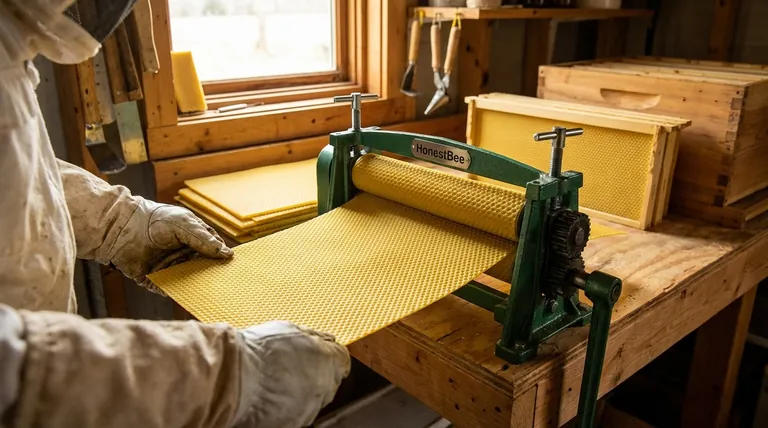In short, wax foundation serves as a guide for honey bees, providing them with a patterned beeswax sheet on which to build straight, orderly honeycomb inside a hive frame. This simple tool dramatically improves the efficiency of the colony and the manageability of the hive for the beekeeper. It is a foundational invention for modern beekeeping practices.
The core purpose of wax foundation is not just to give bees a starting point, but to channel their natural building instincts into a predictable structure. This saves the bees enormous energy and provides the beekeeper with removable frames, which is the key to managing a modern hive.

Why Foundation is a Core Beekeeping Tool
To understand the importance of foundation, one must first understand the costs and challenges of natural comb construction. Without guidance, bees will build comb, but often in ways that make the hive difficult or impossible to manage.
Guiding Construction for Order
Bees are master engineers, but their natural comb can be irregular and wavy. They will often build "cross comb," connecting multiple frames and making it impossible to remove a single frame for inspection without destroying the comb and agitating the colony.
Wax foundation provides a perfectly milled hexagonal pattern that the bees instinctively follow. This encourages them to build straight, even combs contained neatly within a single frame, allowing for easy removal and inspection.
Conserving the Colony's Energy
Producing beeswax is an incredibly energy-intensive process for honey bees. It is estimated that bees must consume 6 to 8 pounds of honey to produce just 1 pound of wax.
By providing a foundation, the beekeeper gives the colony a massive head start. The bees only need to "draw out" the cells from the base sheet, rather than building the entire structure from scratch. This conserved energy can be redirected toward other critical tasks, such as foraging for nectar, raising brood, and increasing honey production.
Ensuring Structural Integrity
Honeycomb filled with honey is heavy. A single deep frame can weigh up to 8 pounds. Foundation provides a stable, durable backbone for the comb.
This added strength prevents the comb from breaking under its own weight, especially in hot weather when wax becomes soft. It is also essential for withstanding the centrifugal force of a honey extractor, a machine used to harvest honey without destroying the comb.
Understanding the Trade-offs: Foundation vs. Foundationless
While foundation is the standard, some beekeepers choose not to use it. Understanding both approaches is key to making an informed decision.
The Case for Foundation
The benefits are clear: faster and straighter comb construction, increased colony efficiency, and stronger combs suitable for mechanical honey extraction. It is the preferred method for beekeepers focused on honey production, pollination services, and ease of management.
The Case for "Foundationless" Beekeeping
Some beekeepers prefer to let bees build their own comb without a guide. The primary argument is that it allows bees to build "natural cell size," which some believe helps them better manage pests like Varroa mites.
However, this approach requires more skill and vigilance. The risk of cross comb is high, and frames are much more fragile, often ruling out the use of a centrifugal extractor. It is typically favored by hobbyists focused on a more "natural" or hands-off philosophy.
Making the Right Choice for Your Hive
The decision to use foundation is a strategic one that should align with your beekeeping goals.
- If your primary focus is honey production and straightforward hive management: Using wax foundation is the most effective path to ensure productive, easy-to-manage colonies.
- If your primary focus is a naturalistic approach and you accept the management challenges: Foundationless beekeeping can be a rewarding experience, but be prepared for irregular combs and slower hive development.
Ultimately, understanding how foundation works empowers you to manage your hives in a way that supports the colony's health and meets your personal goals.
Summary Table:
| Purpose of Wax Foundation | Key Benefit |
|---|---|
| Guides Comb Construction | Ensures straight, even combs for easy frame inspection |
| Conserves Colony Energy | Saves bees from building wax from scratch, boosting productivity |
| Provides Structural Strength | Supports heavy honeycombs and withstands honey extraction |
Ready to enhance your apiary's efficiency?
As a trusted wholesale supplier for commercial apiaries and beekeeping equipment distributors, HONESTBEE provides high-quality wax foundation and essential beekeeping supplies. Our products are designed to maximize your colony's health and honey production, saving you time and increasing your yield.
Contact HONESTBEE today to discuss your wholesale needs and discover how our reliable equipment can support your beekeeping success.
Visual Guide

Related Products
- Manual Beeswax Comb Foundation Machine Wax Foundation Mill Embossing Machine
- Notebook Style Beeswax Foundation Mould Wax Foundation Mold
- Beeswax Foundation Sheets Beehive Foundation for Wholesale
- Colorful Silicone Beeswax Foundation Mold Mould for Beekeeping
- Professional Frame Preparation: The HONESTBEE Electric Wire Embedder
People Also Ask
- What is wax foundation made of? The Essential Guide to Pure Beeswax Foundations
- What are the different uses of comb in a bee hive? A Guide to the Hive's Essential Architecture
- Why is it beneficial to make your own beeswax foundation? Gain Control Over Cost, Purity & Hive Health
- What is the importance of soaping the rollers during milling? Prevent Wax Adhesion & Equipment Downtime
- How should stuck wax on mill rollers be removed? A Gentle, Non-Damaging Cleaning Method


















